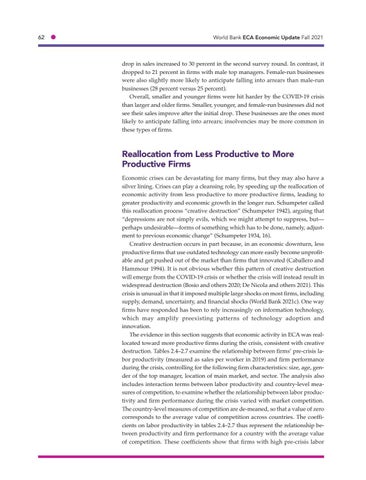62 ●
World Bank ECA Economic Update Fall 2021
drop in sales increased to 30 percent in the second survey round. In contrast, it dropped to 21 percent in firms with male top managers. Female-run businesses were also slightly more likely to anticipate falling into arrears than male-run businesses (28 percent versus 25 percent). Overall, smaller and younger firms were hit harder by the COVID-19 crisis than larger and older firms. Smaller, younger, and female-run businesses did not see their sales improve after the initial drop. These businesses are the ones most likely to anticipate falling into arrears; insolvencies may be more common in these types of firms.
Reallocation from Less Productive to More Productive Firms Economic crises can be devastating for many firms, but they may also have a silver lining. Crises can play a cleansing role, by speeding up the reallocation of economic activity from less productive to more productive firms, leading to greater productivity and economic growth in the longer run. Schumpeter called this reallocation process “creative destruction” (Schumpeter 1942), arguing that “depressions are not simply evils, which we might attempt to suppress, but— perhaps undesirable—forms of something which has to be done, namely, adjustment to previous economic change” (Schumpeter 1934, 16). Creative destruction occurs in part because, in an economic downturn, less productive firms that use outdated technology can more easily become unprofitable and get pushed out of the market than firms that innovated (Caballero and Hammour 1994). It is not obvious whether this pattern of creative destruction will emerge from the COVID-19 crisis or whether the crisis will instead result in widespread destruction (Bosio and others 2020; De Nicola and others 2021). This crisis is unusual in that it imposed multiple large shocks on most firms, including supply, demand, uncertainty, and financial shocks (World Bank 2021c). One way firms have responded has been to rely increasingly on information technology, which may amplify preexisting patterns of technology adoption and innovation. The evidence in this section suggests that economic activity in ECA was reallocated toward more productive firms during the crisis, consistent with creative destruction. Tables 2.4–2.7 examine the relationship between firms’ pre-crisis labor productivity (measured as sales per worker in 2019) and firm performance during the crisis, controlling for the following firm characteristics: size, age, gender of the top manager, location of main market, and sector. The analysis also includes interaction terms between labor productivity and country-level measures of competition, to examine whether the relationship between labor productivity and firm performance during the crisis varied with market competition. The country-level measures of competition are de-meaned, so that a value of zero corresponds to the average value of competition across countries. The coefficients on labor productivity in tables 2.4–2.7 thus represent the relationship between productivity and firm performance for a country with the average value of competition. These coefficients show that firms with high pre-crisis labor



